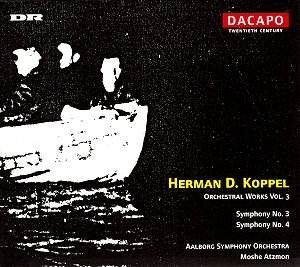Koppel wrote seven
symphonies between 1930 and 1961. After
writing his first two symphonies his
next two followed in short order.
This Third Symphony
is unsettled and exuding anxiety.
The music, said Koppel, reflects the
fears he had for his native Denmark
during Swedish exile. Koppel, with his
Jewish origins, had fled his homeland
from Nazi occupation. The Symphony is
in a single half hour movement. The
music is preoccupied with melody often
of a consolatory hymnal character (9.03)
against an emotion-bleached 'landscape'.
There is room for some searingly cold
peck-and-chatter for woodwind which
works powerfully when counter-pointed
with tense but pliant writing for the
strings as at 11.40. This symphony can
be bracketed with the scalding heat
of the contemporary American symphonies
such as the Thirds of Diamond, Harris
and Schuman. There is little sign of
confidence in this music, consolation
perhaps (27.01 et seq) but the outcome
remains something feared rather than
hoped for. The tense quiet music in
which this symphony abounds finds echoes
and pre-echoes in the adagios of the
Shostakovich symphonies (10-12), in
Nystroem's Sinfonia del mare and
in Allan Pettersson's Symphonies 7-9.
This is a powerful piece moving between
the poles of depression and an uncertain
consolation.
The Fourth Symphony
was written on his return to Denmark
after the end of the war. It opens with
a masterly col legno rhythmic
whisper and a languidly progressive
clarinet arabesque. The music then refers
briefly back to Nielsen in the pastoral
idylls of the middle movement of his
Fourth Symphony. The whispered clatter
continues and proves itself an idée
fixe for the whole movement giving
it a satisfying sense of organic unity.
The short intermezzo is playfully purposeful
in the mood of a Sinfonietta with a
twist of Kurt Weill in there as well.
The rhythmic patterns link with the
first movement. The finale is a substantial
piece of music (13 minutes). Bitter
and biting brass writing at the peak
of the movement contrasts with substantial
quiet sections. The uncertainty, the
sense of looking fearfully over the
shoulder, is still there. The skilfully
exuberant pages that constitute the
finale seem a shying away into orthodoxy
when so much of the symphony has treated
of pessimism and fear head-on.
This disc again has
good notes by Jens Cornelius and is
a companion to Vol. 1 8.224135
and Vol. 2 8.224205
both reviewed here.
The usual exemplary
high production, technical and artistic
values are in evidence in this presentation
of two symphonies exploring Nordic portents
and angst.
Rob Barnett
